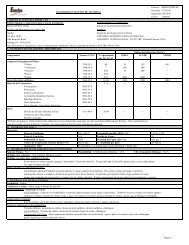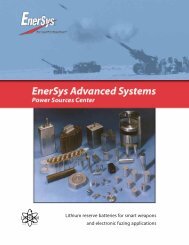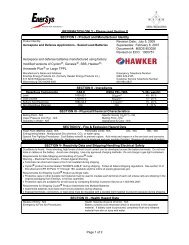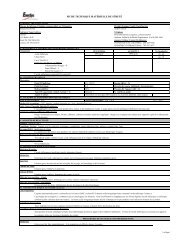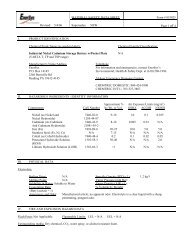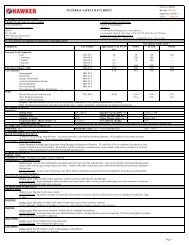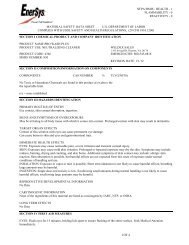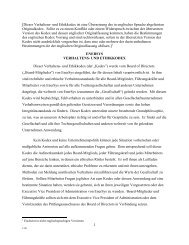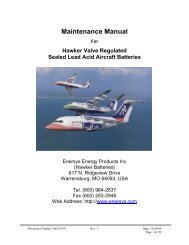enersys inc hawker - Cantec Systems
enersys inc hawker - Cantec Systems
enersys inc hawker - Cantec Systems
You also want an ePaper? Increase the reach of your titles
YUMPU automatically turns print PDFs into web optimized ePapers that Google loves.
ENERSYS INC<br />
HAWKER<br />
TECHNICAL MANUAL<br />
ARMASAFE PLUS BATTERY<br />
NSN 6140-01-485-1472<br />
HAWKER Part No 9750N7025<br />
MAINTENANCE GUIDE<br />
Doc Ref : 2602-0052 Rev 00
LIST OF EFFECTIVE PAGES<br />
Doc Ref : 2602-0052 Rev 00<br />
Insert latest pages; dispose of superseded pages in accordance with applicable regulations.<br />
Dates of issue for original and changed pages are:<br />
Original issue 0 dd Mmm 20YY<br />
TOTAL NUMBER OF PAGES IN THIS PUBLICATION IS 13, CONSISTING OF THE<br />
FOLLOWING:<br />
Page No. Change No. *<br />
Title .......................................................... 0<br />
A............................................................... 0<br />
i-vi............................................................. 0<br />
1-1............................................................. 0<br />
1-2............................................................. 0<br />
1-3............................................................. 0<br />
1-4............................................................. 0<br />
1-5............................................................. 0<br />
* Zero in this column indicates an original page.<br />
A
TABLE OF CONTENTS<br />
Doc Ref : 2602-0052 Rev 00<br />
Section Page<br />
TITLE PAGE<br />
LIST OF EFFECTIVE PAGES A<br />
TABLE OF CONTENTS i<br />
LIST OF ILLUSTRATIONS ii<br />
LIST OF TABLES ii<br />
WARNINGS AND CAUTIONS iii<br />
INTRODUCTION iv-vi<br />
1 MAINTENANCE PROCEDURES 1-1<br />
Receipt of New Material 1-1<br />
Storage 1-1<br />
Test Equipment 1-2<br />
Commissioning 1-2<br />
Charging Procedures 1-3<br />
Deep Discharge Recovery Procedure 1-3<br />
Capacity Test Procedure 1-4<br />
Inspection, Off-Vehicle 1-4<br />
Failed Batteries 1-5<br />
TROUBLESHOOTING<br />
2 General 1-5<br />
i
LIST OF ILLUSTRATIONS<br />
Doc Ref : 2602-0052 Rev 00<br />
Figure Page<br />
1 Sealed Lead-Acid Battery 6140-01-485-1472 iv<br />
2 Charge Retention during Storage 1-1<br />
3 Date of Initial Installation Label 1-2<br />
4 State-of-Charge vs OCV 1-4<br />
LIST OF TABLES<br />
Table Page<br />
1 Charging Equipment 1-2<br />
2 Constant Voltage Charge Duration 1-3<br />
3 Fault Isolation 1-5
WARNINGS<br />
Doc Ref : 2602-0052 Rev 00<br />
1. Short circuit currents can exceed 3500 Amps; all tools must be insulated. Care must be taken with<br />
all items of metal in clothing and jewellery, such as buckles, zips, rings, watches, chains etc.<br />
2. No attempt should be made to introduce any substances, e.g. acid or de-ionised water to the<br />
battery.<br />
3. After charging batteries should be left for a minimum of 4 hours before further maintenance or<br />
issue.<br />
u uuu uu uu uu uuu uu uu uuu<br />
CAUTIONS<br />
u uuu uu uu uu uuu uu uu uuu<br />
1. Batteries should not be left in a discharged state following a capacity test.<br />
2. Do not subject batteries to shock loads such as dropping on to a bench.<br />
3. Ensure separate tools are used for maintenance of lead-acid and nickel-cadmium batteries.<br />
ii<br />
iii
INTRODUCTION<br />
Doc Ref : 2602-0052 Rev 00<br />
1. PURPOSE OF THIS MANUAL<br />
Provides maintenance instructions if required for servicing of the Armasafe Plus Battery<br />
NSN 6140-01-485-1472, Hawker P/N 9750N7025.<br />
2. SCOPE OF THIS MANUAL<br />
Provides start-to-finish, step by step maintenance actions such as Incoming inspection,<br />
commissioning, recharging; capacity testing, and trouble shooting.<br />
3. BATTERY DESCRIPTION<br />
This Hawker lead acid battery is a sealed, valve regulated system. Under normal<br />
operating conditions no servicing is required however should the need arise this manual<br />
outlines the necessary instructions.<br />
The battery is maintenance free with respect to electrolyte replenishment. Under no<br />
circumstances should any attempt be made to introduce any substances, e.g. acid,<br />
distilled water or alkali to the battery.<br />
Sealed Lead Acid Battery 6140-01-485-1472<br />
HAWKER Part No 9750N7025<br />
Figure 1<br />
iv
Doc Ref : 2602-0052 Rev 00<br />
The battery consists of six 2v cells connected in series contained in a polypropylene<br />
container. Electrical connection is via the positive and negative terminal posts.<br />
Leading Particulars are :-<br />
Nominal Voltage 12V<br />
Electrical Capacity 120Ah (20 Hour)<br />
110Ah (10 Hour)<br />
100Ah (5 Hour)<br />
80Ah (1 Hour)<br />
CCA (S.A.E) 1225A<br />
Reserve Capacity 240 Minutes<br />
Mass 86lb (39Kg)<br />
Storage 2 years at 20ºC (before recharge)<br />
Overall Length 10.51” (267 mm) Max<br />
Overall Width 11.26” (286) mm Max (<strong>inc</strong>luding handles)<br />
Overall Height 9.05” (230 mm) Max<br />
Case Material Polypropylene<br />
Terminals Posts to SAE J537<br />
Hawker Military Batteries have been independently tested to, and are classified as Non-<br />
Spillable and exempt from hazardous goods transportation requirements, in accordance with<br />
:-<br />
a) ICAO/IATA Packing Instruction 806, Special Provision A67.<br />
b) IMDG Class 8, UN ID 2800, exemption for Non-Spillable batteries.<br />
c) USA Dept of Transportation - 49 CFR Section 173.159 para d.<br />
When securely packaged and protected against short circuits.<br />
4. NON-STANDARD ABBREVIATIONS<br />
The following non-standard abbreviations are used in this manual:<br />
SLAB Sealed Lead Acid Battery<br />
OCV Open Circuit Voltage
5. CHANGE RECOMMENDATIONS<br />
Doc Ref : 2602-0052 Rev 00<br />
Recommendations concerning changes to this manual should be submitted to the<br />
manufacturer :-<br />
ENERSYS INC<br />
Formerly HAWKER<br />
617 N. Ridgeview Dr.<br />
Warrensburg, MO 64093<br />
United States of America<br />
Tel (800) 964-2837<br />
Fax (800) 283-2948<br />
v
1-1. RECEIPT OF NEW MATERIAL<br />
SECTION 1<br />
MAINTENANCE PROCEDURES<br />
Doc Ref : 2602-0052 Rev 00<br />
1. All batteries are despatched from the manufacturing plant in a fully charged condition, the date<br />
of the latest charge being marked on the outer packaging and on the battery identification label.<br />
The only acceptance check required immediately upon receipt is to look for signs of damage<br />
in transit. Unpacking and detailed examination is unnecessary and should be left until the<br />
battery is removed from storage.<br />
1-2. STORAGE<br />
1. It is recommended that the fully charged battery should be stored in the original carton, in a cool<br />
dry place, ideally below 77 ° F (25ºC). The battery charge retention will be reduced with <strong>inc</strong>reased<br />
temperature.<br />
2. The graph in Figure 2 demonstrates typical capacity retention of the battery during storage<br />
without regular boost charges.<br />
Open<br />
Circuit<br />
Voltage<br />
13.00<br />
12.95<br />
12.90<br />
12.85<br />
12.80<br />
12.75<br />
12.70<br />
12.65<br />
12.60<br />
+40°C<br />
+30°C<br />
+25°C<br />
+20°C<br />
0 6 12 18 24 30 36 42 48<br />
Months self discharge<br />
+15°C<br />
Charge Retention During Storage<br />
Figure 2<br />
+10°C<br />
100.0<br />
3. The battery may be stored up to 5 years without degradation of performance provided that an<br />
OCV check is conducted every 12 months. When stored in temperatures in excess of 95°F<br />
96.3<br />
92.5<br />
88.8<br />
85.0<br />
81.3<br />
77.5<br />
73.8<br />
70.0<br />
Approx<br />
% state<br />
of<br />
charge<br />
vi
Doc Ref : 2602-0052 Rev 00<br />
(35°C), the battery should be inspected every 6 months. If the OCV falls below 12.6V, the battery<br />
should be charged in accordance with para 1-5.<br />
1-3. TEST EQUIPMENT<br />
1. Electronic Multimeter. 0 - 50 Volts, precision ± 0.5% or better.<br />
2. Charge/Discharge Connection Lead.<br />
3. Discharge Unit. This must be capable of discharging the battery at a constant current of 20A ±<br />
0.5A over a voltage range of 13 to 10 V.<br />
4. Charger. Acceptable charger requirements are shown in Table 1.<br />
METHOD EQUIPMENT<br />
Constant Voltage Voltage Regulated Battery Charger capable of 14.25V, and 20A<br />
Minimum<br />
Charging Equipment<br />
Table 1<br />
5. The batteries are sealed and therefore do not require a dedicated lead acid battery room. A<br />
normal electrical workshop or a nickel-cadmium battery room can be used.<br />
1-4. COMMISSIONING<br />
1. When required for use, remove the battery from storage and perform the checkout detailed<br />
below.<br />
2. Visually inspect the exterior of the battery for signs of damage, cracks, corrosion etc. If the<br />
condition is unsatisfactory, quarantine the battery and inform the manufacturer.<br />
3. Measure the OCV.<br />
4. If the OCV is greater than or equal to 12.75 volts, the battery can be prepared for issue.<br />
5. If the OCV is less than or equal to 12.75 volts, charge in accordance with para 1-5.<br />
6. Wipe the battery external surfaces clean with a soft dry cloth.<br />
7. Prior to issue for installation, mark each new battery permanently with the date of initial<br />
installation (month/year) on the lid label.<br />
1-1
1-5. CHARGING PROCEDURES<br />
Figure 3<br />
Doc Ref : 2602-0052 Rev 00<br />
1. Charging should be conducted at a temperature between +68° and 86°F (+20° and 30°C ).<br />
Charging can be accomplished by two methods.<br />
(N.B. Constant Voltage is the preferred method.)<br />
2. Constant Voltage. Charge at a constant voltage (14.25 +/- 0.25 Volts), with a charger with a<br />
minimum current availability of 20 amps, for 6 hours.<br />
NOTE: The higher the available current the faster the battery will recharge. The charge may be<br />
discontinued when current falls to ≤ 0.50 A. Typical durations are shown in Table 2.<br />
Current<br />
Available<br />
Charge Time<br />
10A 14 Hours<br />
20A 7 Hours<br />
30A 5 Hours<br />
Constant Voltage Charge Duration<br />
Table 2<br />
3. Constant Current<br />
As mentioned above constant voltage charging is the preferred method recommended by the<br />
manufacturer, if the only option available is constant current charging the manufacturer needs to<br />
be contacted for advice on the correct procedures.<br />
1-6. DEEP DISCHARGE RECOVERY PROCEDURE<br />
1. If a battery is heavily discharged, usually due to a low current drain, it is said to be in a deeply<br />
discharged state. This becomes apparent when the OCV is less than 10 volts.<br />
2. Constant voltage charge, using a standard charger set at 14.25v +/-.25v. Restrict the<br />
maximum available current to 5 amps, initially the battery may appear as if it is not accepting<br />
charge, (this is due to the sulphation barrier that builds up within a deep discharged battery)<br />
but after approximately 20 minutes the current should begin to flow.<br />
1-2
Doc Ref : 2602-0052 Rev 00<br />
This is the safest method of recovery but can take 36 hours or more to fully recover the<br />
battery.<br />
3. Perform a Capacity test in accordance with para 1-7. A battery that provides less than 300<br />
Minutes (100%) duration but in excess of 240 Minutes (80%) is still suitable for use and may<br />
benefit from additional charging.<br />
4. If the discharge duration is less than 240 Minutes, it may be assumed that the battery is unlikely<br />
to be recovered and it should be rejected.<br />
5. Recharge in accordance with para 1-5.<br />
1-7. CAPACITY TEST PROCEDURE<br />
1. Allow the battery to stabilise for 4 Hours after charging or after exposure to ambient<br />
temperature of less than +68°F (+20°C).<br />
2. The discharge test should be conducted with the battery at a temperature of between 68° and<br />
77° F (+20° and +25°C).<br />
2. Discharge the battery at 20A for 300 Minutes or to 10V whichever occurs first.<br />
3. Recharge in accordance with para 1-5.<br />
1-8. INSPECTION, OFF-VEHICLE<br />
1. Visually inspect the exterior of the battery for signs of damage, cracks, corrosion etc. If the<br />
condition is unsatisfactory, reject the battery.<br />
2. Measure the OCV of the battery. Figure 3 gives an approximate guide to the battery’s state-ofcharge.<br />
1-3
%<br />
State<br />
of<br />
Charge<br />
C 20<br />
100<br />
90<br />
80<br />
70<br />
60<br />
50<br />
40<br />
30<br />
20<br />
10<br />
State-of-Charge vs OCV<br />
Figure 4<br />
Doc Ref : 2602-0052 Rev 00<br />
0<br />
11.3 11.4 11.5 11.6 11.7 11.8 11.9 12.0 12.1 12.2 12.3 12.4 12.5 12.6 12.7 12.8 12.9 13.0<br />
If the OCV is less than 10V but above 4V, carry out Deep Discharge Recovery in accordance with<br />
para 1-6. Otherwise, charge in accordance with para 1-5.<br />
5. Perform a Capacity Test in accordance with para 1-7. Charge the battery in accordance with<br />
para 1-5. If the discharge duration is equal to or in excess of 240 minutes, prepare the battery<br />
for issue.<br />
6. Otherwise, repeat step 5, twice if necessary, to achieve 240 Minutes discharge duration.<br />
7. If the battery still fails to achieve 240 Minutes minimum, reject the battery.<br />
1-9 FAILED BATTERIES<br />
Rested OCV<br />
1. The battery is a non-repairable unit, and is covered by a limited warranty. To determine<br />
warranty status, read the date of commissioning marked on the battery. If less than one year<br />
has elapsed, the battery is still under warranty.<br />
2. Failed batteries that are under warranty should be fully charged if possible, and notification,<br />
together with service history and fault particulars, sent to the manufacturer.<br />
3. Failed batteries that are not under warranty should be disposed of in accordance with Federal,<br />
State & Local regulations. The battery contains some hazardous materials.<br />
SECTION 2<br />
1-4
2.1 General<br />
Use Table 3 as a guide to fault isolation.<br />
TROUBLESHOOTING<br />
TROUBLE POSSIBLE CAUSE ACTION<br />
Zero battery Broken or loose terminal Reject battery<br />
Voltage<br />
connections, or open-circuit<br />
battery.<br />
Low Volts off<br />
vehicle<br />
Charger malfunction<br />
Check charger<br />
Discharged battery<br />
Service in accordance with<br />
manual<br />
Defective battery cell<br />
Fault Isolation<br />
Table 3<br />
Reject battery<br />
Doc Ref : 2602-0052 Rev 00<br />
1-5




